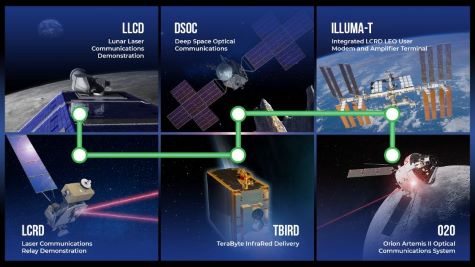26 Oct 2023
IILLUMA-T system is heading to ISS next month to showcase benefits for missions in low Earth orbit.
NASA is poised to demonstrate laser communications on multiple missions – to show the benefits infrared light can have for science and exploration missions transmitting terabytes of important data.In November, the International Space Station will host a “flashy” technology demonstration, NASA announced this week. The ILLUMA-T (Integrated Laser Communications Relay Demonstration Low Earth Orbit User Modem and Amplifier Terminal) payload is launching to the ISS to show how missions in low Earth orbit can benefit from laser communications.
Managed by NASA’s Space Communications and Navigation program, ILLUMA-T is completing NASA’s first bi-directional, end-to-end laser communications relay by working with the agency’s Laser Communications Relay Demonstration (LCRD).
LCRD launched in December 2021 and is currently demonstrating the benefits of laser communications from geosynchronous orbit by transmitting data between two ground stations on Earth in a series of experiments.
Some of LCRD’s experiments include studying atmospheric impact on laser signals, confirming its ability to work with multiple users, testing network capabilities like delay/disruption tolerant networking over laser links, and investigating improved navigation capabilities.
Once ILLUMA-T is installed on the space station’s exterior, the payload will complete NASA’s first in-space demonstration of two-way laser relay capabilities.

NASA’s Laser Communications Roadmap.
ILLUMA-T’s optical module comprises a telescope and two-axis gimbal which allows pointing and tracking of LCRD in geosynchronous orbit. The optical module is about the size of a microwave and the payload itself is comparable to a standard refrigerator.
ILLUMA-T will relay data from the space station to LCRD at 1.2 Gbit/s, then LCRD will send the data down to optical ground stations in California or Hawaii. Once the data reaches these ground stations, it will be sent to the LCRD Mission Operations Center located at NASA’s White Sands Complex in Las Cruces, New Mexico.
“NASA Goddard’s primary role is to ensure successful laser communications and payload operations with LCRD and the space station,” commented ILLUMA-T Deputy Project Manager Matt Magsamen.
“With LCRD actively conducting experiments that test and refine laser systems, we are looking forward to taking space communications capabilities to the next step and watching the success of this collaboration between the two payloads unfold,” he said.
Data rate increaseOnce ILLUMA-T transmits its first beam of laser light through its optical telescope to LCRD, the end-to-end laser communications experiment begins. After its experimental phase with LCRD, ILLUMA-T could become an operational part of the space station and substantially increase the amount of data NASA can send to and from the orbiting laboratory.
NASA stated that “Laser communications could be a game-changer for researchers on Earth with science and technology investigations aboard the space station. Astronauts conduct research in areas like biological and physical sciences, technology, Earth observations, and more in the orbiting laboratory for the benefit of humanity.”
ILLUMA-T could provide enhanced data rates for these experiments and send more data back to Earth at once. In fact, at 1.2 Gbit/s, ILLUMA-T can transfer the amount of data equivalent to an average movie in under a minute.
| © 2024 SPIE Europe |
|